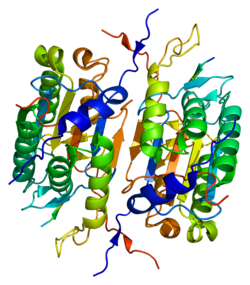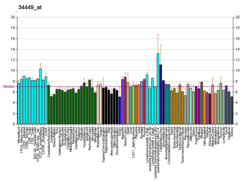Caspase 2
Caspase 2 also known as CASP2 is an enzyme that, in humans, is encoded by the CASP2 gene.[5] CASP2 orthologs [6] have been identified in nearly all mammals for which complete genome data are available. Unique orthologs are also present in birds, lizards, lissamphibians, and teleosts.
Function
Sequential activation of caspases plays a central role in the execution-phase of cell apoptosis. Caspases exist as inactive proenzymes that undergo proteolytic processing at conserved aspartic residues to produce two subunits, large and small, that dimerize to form the active enzyme. The proteolytic cleavage of this protein is induced by a variety of apoptotic stimuli.[7]
Caspase 2 proteolytically cleaves other proteins. It belongs to a family of cysteine proteases called caspases that cleave proteins only at an amino acid following an aspartic acid residue. Within this family, caspase 2 is part of the Ich-1 subfamily. It is one of the most conserved caspases in different species of animal. Caspase 2 has a similar amino acid sequence to initiator caspases, including caspase 1, caspase 4, caspase 5, and caspase 9. It is produced as a zymogen, which contains a long pro-domain that is similar to that of caspase 9 and contains a protein interaction domain known as a CARD domain. Pro-caspase-2 contains two subunits, p19 and p12.
It has been shown to associate with several proteins involved in apoptosis using its CARD domain, including RIP-associated Ich-1/Ced-3-homologue protein with a death domain (RAIDD), apoptosis repressor with caspase recruitment domain (ARC), and death effector filament-forming Ced-4-like apoptosis protein (DEFCAP).[8] Together with RAIDD and p53-induced protein with a death domain ([PIDD])(LRDD), caspase 2 has been shown to form the so-called PIDDosome,[9] which may serve as an activation platform for the protease, although it may also be activated in the absence of PIDD.[10] Overall, caspase 2 appears to be a very versatile caspase with multiple functions beyond cell death induction.[11][12]
Interactions
Caspase 2 has been shown to interact with:
See also
References
- ^ a b c GRCh38: Ensembl release 89: ENSG00000106144 – Ensembl, May 2017
- ^ a b c GRCm38: Ensembl release 89: ENSMUSG00000029863 – Ensembl, May 2017
- ^ "Human PubMed Reference:". National Center for Biotechnology Information, U.S. National Library of Medicine.
- ^ "Mouse PubMed Reference:". National Center for Biotechnology Information, U.S. National Library of Medicine.
- ^ Kumar S, White DL, Takai S, Turczynowicz S, Juttner CA, Hughes TP (June 1995). "Apoptosis regulatory gene NEDD2 maps to human chromosome segment 7q34-35, a region frequently affected in haematological neoplasms". Hum. Genet. 95 (6): 641–4. doi:10.1007/bf00209480. PMID 7789948.
- ^ "OrthoMaM phylogenetic marker: CASP2 coding sequence". Archived from the original on 24 September 2015. Retrieved 20 December 2009.
- ^ "Entrez Gene: CASP2".
- ^ Zhivotovsky B, Orrenius S (2005). "Caspase-2 function in response to DNA damage". Biochem. Biophys. Res. Commun. 331 (3): 859–67. doi:10.1016/j.bbrc.2005.03.191. PMID 15865942.
- ^ a b Tinel A, Tschopp J (May 2004). "The PIDDosome, a protein complex implicated in activation of caspase-2 in response to genotoxic stress". Science. 304 (5672): 843–6. doi:10.1126/science.1095432. PMID 15073321.
- ^ Manzl C, Krumschnabel G, Bock F, Sohm B, Labi V, Baumgartner F, Logette E, Tschopp J, Villunger A (April 2009). "Caspase-2 activation in the absence of PIDDosome formation". J. Cell Biol. 185 (2): 291–303. doi:10.1083/jcb.200811105. PMC 2700374. PMID 19364921.
- ^ Krumschnabel G, Manzl C, Villunger A (September 2009). "Caspase-2: killer, savior and safeguard--emerging versatile roles for an ill-defined caspase". Oncogene. 28 (35): 3093–6. doi:10.1038/onc.2009.173. PMC 3272399. PMID 19581929.
- ^ Krumschnabel G, Sohm B, Bock F, Manzl C, Villunger A (February 2009). "The enigma of caspase-2: the laymen's view". Cell Death Differ. 16 (2): 195–207. doi:10.1038/cdd.2008.170. PMC 3272397. PMID 19023332.
- ^ a b Guo Y, Srinivasula SM, Druilhe A, Fernandes-Alnemri T, Alnemri ES (April 2002). "Caspase-2 induces apoptosis by releasing proapoptotic proteins from mitochondria". J. Biol. Chem. 277 (16): 13430–7. doi:10.1074/jbc.M108029200. PMID 11832478.
- ^ Paroni G, Henderson C, Schneider C, Brancolini C (June 2001). "Caspase-2-induced apoptosis is dependent on caspase-9, but its processing during UV- or tumor necrosis factor-dependent cell death requires caspase-3". J. Biol. Chem. 276 (24): 21907–15. doi:10.1074/jbc.M011565200. PMID 11399776.
- ^ Droin N, Beauchemin M, Solary E, Bertrand R (December 2000). "Identification of a caspase-2 isoform that behaves as an endogenous inhibitor of the caspase cascade". Cancer Res. 60 (24): 7039–47. PMID 11156409.
- ^ Duan H, Dixit VM (January 1997). "RAIDD is a new 'death' adaptor molecule" (PDF). Nature. 385 (6611): 86–9. doi:10.1038/385086a0. PMID 8985253.
- ^ Srinivasula SM, Ahmad M, Fernandes-Alnemri T, Litwack G, Alnemri ES (December 1996). "Molecular ordering of the Fas-apoptotic pathway: the Fas/APO-1 protease Mch5 is a CrmA-inhibitable protease that activates multiple Ced-3/ICE-like cysteine proteases". Proc. Natl. Acad. Sci. U.S.A. 93 (25): 14486–91. doi:10.1073/pnas.93.25.14486. PMC 26159. PMID 8962078.
External links
- The MEROPS online database for peptidases and their inhibitors: C14.006
- Overview of all the structural information available in the PDB for UniProt: P42575 (Human Caspase-2) at the PDBe-KB.
This article incorporates text from the United States National Library of Medicine, which is in the public domain.








